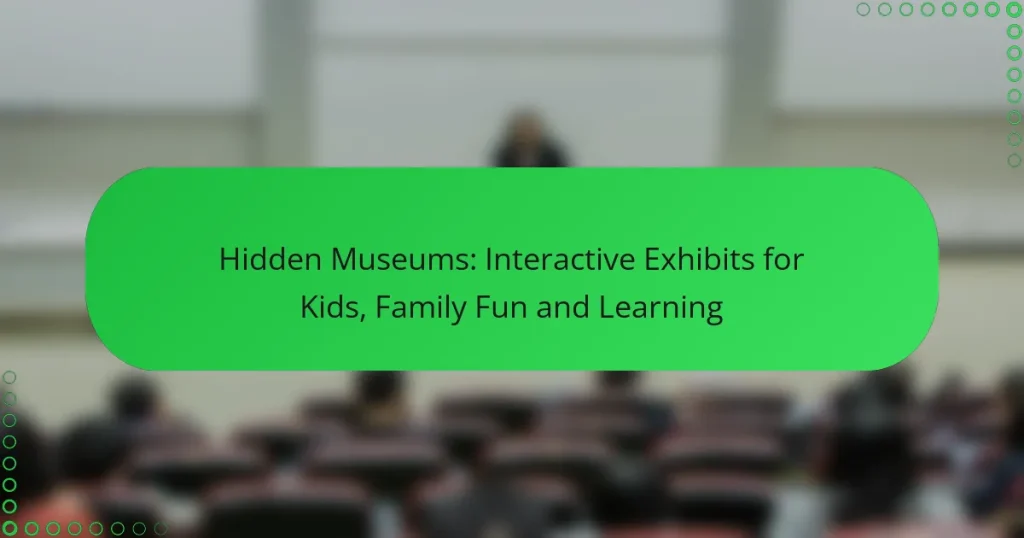Discover the charm of hidden museums across the US, where interactive exhibits captivate kids and families alike. These unique venues blend education and entertainment, offering hands-on experiences that inspire curiosity and foster learning through play. Perfect for family outings, these museums create dynamic environments where both children and adults can explore and enjoy the wonders of discovery together.

What Are the Best Hidden Museums for Kids in the US?
The best hidden museums for kids in the US offer engaging, interactive exhibits that promote learning through play. These venues provide unique experiences that combine education and entertainment, making them ideal for family outings.
Children’s Museum of Indianapolis
The Children’s Museum of Indianapolis is the largest children’s museum in the world, featuring a variety of interactive exhibits that encourage hands-on learning. Kids can explore everything from dinosaurs to space exploration, making it a fantastic destination for curious minds.
Consider visiting the museum’s outdoor areas, which often include seasonal activities and events. Check their website for special programs and ticket prices, which typically range from $15 to $25 for children and adults.
Exploratorium in San Francisco
The Exploratorium is a unique museum that emphasizes science and art through interactive exhibits. Located on the Embarcadero, it offers a range of activities that invite children to experiment and discover scientific principles in a fun way.
Families can enjoy hands-on experiments and demonstrations that change daily. Admission prices are around $30 for adults and $20 for children, with discounts available for families and groups.
Boston Children’s Museum
The Boston Children’s Museum focuses on early childhood education and cultural awareness through interactive exhibits. Children can engage in activities that explore art, science, and the world around them, making it a great place for learning and play.
Be sure to check out their special events and programs, which often include themed days and workshops. Admission is generally around $20 for adults and $15 for children, with free admission for Boston residents on certain days.
Brooklyn Children’s Museum
The Brooklyn Children’s Museum is known for its innovative exhibits that encourage exploration and creativity. With a focus on cultural diversity, the museum offers programs that celebrate various communities and traditions.
Families can participate in hands-on activities and workshops that change regularly. Admission is typically around $13 for adults and $11 for children, with free admission for Brooklyn residents on specific days.
Discovery Cube in Los Angeles
Discovery Cube in Los Angeles is a science museum that provides interactive exhibits designed to inspire children to learn about science and technology. The museum features a variety of themed areas, including space, health, and the environment.
Check their calendar for special events and traveling exhibits that may be available during your visit. Admission prices usually range from $15 to $20 for children and adults, with discounts for groups and memberships available.
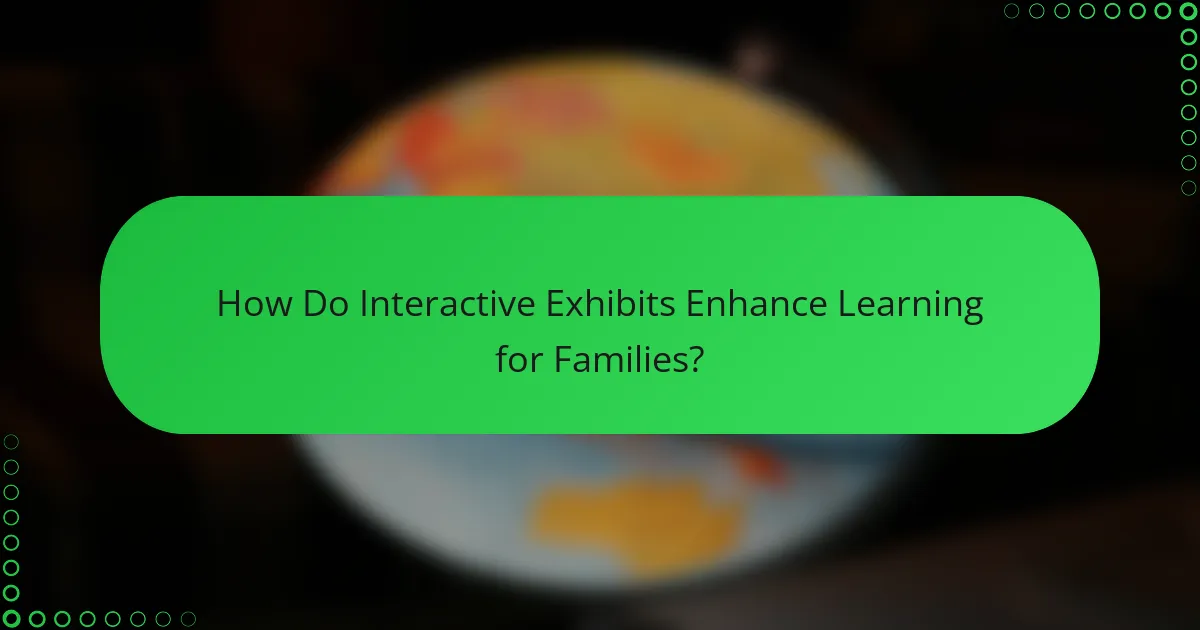
How Do Interactive Exhibits Enhance Learning for Families?
Interactive exhibits enhance learning for families by providing engaging, hands-on experiences that make education enjoyable. These exhibits encourage exploration and curiosity, allowing children and adults to learn together in a dynamic environment.
Hands-on Learning Experiences
Hands-on learning experiences are central to interactive exhibits, enabling families to engage directly with the material. For instance, science centers often feature experiments where children can mix chemicals or build simple machines, fostering a deeper understanding of concepts.
These experiences cater to various learning styles, allowing visual, auditory, and kinesthetic learners to thrive. Families can participate in activities such as art creation, historical reenactments, or interactive storytelling, making learning memorable.
Encouragement of Critical Thinking
Interactive exhibits promote critical thinking by presenting challenges that require problem-solving skills. For example, escape rooms in museums often ask families to work together to solve puzzles, encouraging collaboration and analytical thinking.
By navigating these challenges, children learn to ask questions, hypothesize, and test their ideas. This process not only enhances their cognitive abilities but also builds confidence in their problem-solving skills.
Engagement Through Play
Engagement through play is a key aspect of interactive exhibits, making learning fun and enjoyable for families. Play-based learning environments, such as children’s museums, allow kids to explore concepts through games and imaginative play.
Activities like role-playing in a mock grocery store or building structures with blocks help children grasp complex ideas while having fun. This playful approach keeps children interested and motivated, leading to a more effective learning experience.

What Are the Top Interactive Exhibits for Family Fun?
The best interactive exhibits for family fun combine education with hands-on activities that engage children and adults alike. These experiences often encourage exploration and creativity, making learning enjoyable for the whole family.
Science Experiments at the Exploratorium
The Exploratorium in San Francisco offers a wide range of interactive science experiments that captivate visitors of all ages. Families can engage with exhibits that cover topics from physics to biology, allowing kids to conduct their own experiments and discover scientific principles firsthand.
Popular activities include the Tactile Dome, where visitors navigate through a dark maze using only their sense of touch, and the outdoor science park, which features large-scale installations that encourage physical interaction. Admission prices typically range from $20 to $30 for adults, with discounts for children and families.
Art Activities at the Children’s Museum of Indianapolis
The Children’s Museum of Indianapolis features numerous art activities designed to inspire creativity in young visitors. Children can participate in hands-on art projects, such as painting, sculpting, and crafting, often using recycled materials to promote sustainability.
Special workshops are frequently offered, allowing families to learn from local artists and create unique pieces together. Admission costs around $25 for adults, with reduced rates for children and members, making it an affordable option for family outings.
Interactive History Exhibits at Boston Children’s Museum
The Boston Children’s Museum provides interactive history exhibits that immerse families in the past through engaging activities. Kids can explore different cultures and historical events via role-playing and interactive displays, making history come alive.
Exhibits like the “Construction Zone” allow children to build structures while learning about engineering, while the “KidStage” offers opportunities for storytelling and performance. Tickets are generally priced at about $20 for adults, with discounts available for children and families, ensuring accessibility for all.
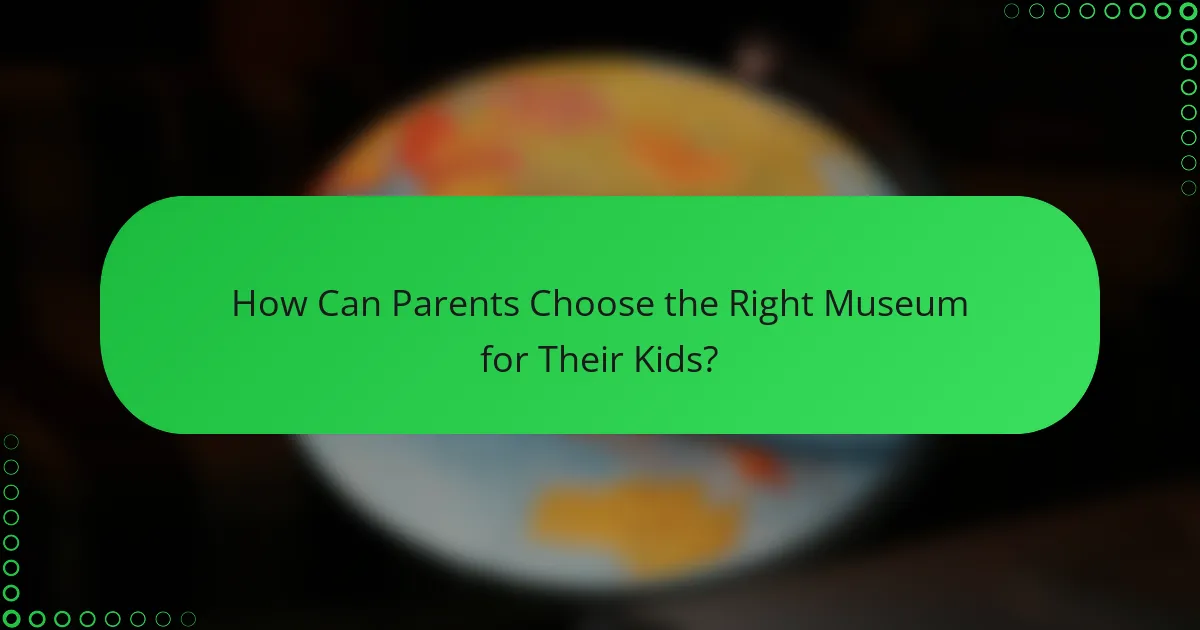
How Can Parents Choose the Right Museum for Their Kids?
Parents can choose the right museum for their kids by considering factors such as age appropriateness, educational value, and accessibility features. These elements ensure that the museum experience is engaging, informative, and suitable for children of varying needs and interests.
Consider Age Appropriateness
When selecting a museum, it’s crucial to assess whether the exhibits are designed for your child’s age group. Many museums categorize their offerings by age, providing guidelines on which exhibits are suitable for toddlers, preschoolers, or older children.
For instance, interactive exhibits that encourage hands-on participation are often more engaging for younger kids, while older children may benefit from more complex themes and deeper educational content. Always check the museum’s website or contact them directly for age recommendations.
Look for Educational Value
Educational value is a key factor in choosing a museum. Look for institutions that emphasize learning through interactive exhibits, workshops, and guided tours tailored for children. Museums that align with school curricula can enhance your child’s understanding of subjects like science, history, or art.
Consider visiting museums that offer special programs or events, such as science fairs or art classes, which can provide additional learning opportunities. Reading reviews or asking other parents can help identify which museums deliver the best educational experiences for kids.
Check for Accessibility Features
Accessibility is essential for ensuring all children can enjoy the museum experience. Check if the museum has features like ramps, elevators, and accessible restrooms to accommodate children with mobility challenges. Many museums also offer sensory-friendly hours or quiet spaces for children who may become overwhelmed.
It’s advisable to review the museum’s accessibility information on their website or call ahead to inquire about specific needs. This preparation can help ensure a smooth and enjoyable visit for everyone in the family.
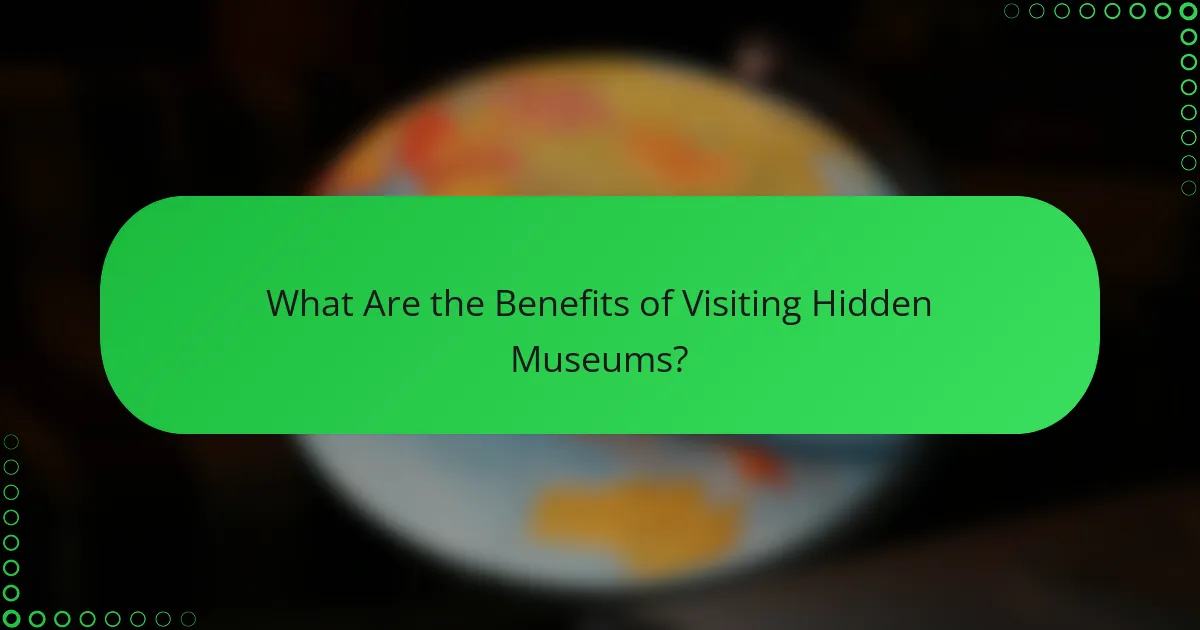
What Are the Benefits of Visiting Hidden Museums?
Visiting hidden museums offers unique advantages that enhance family fun and learning experiences. These lesser-known venues often provide interactive exhibits that engage children and foster a deeper understanding of various subjects.
Unique Learning Opportunities
Hidden museums frequently feature specialized exhibits that are not available in larger institutions. These exhibits often focus on niche topics, allowing children to explore areas of interest in depth. For example, a small museum dedicated to local history might include hands-on activities that make learning more engaging.
Interactive displays encourage kids to participate actively, which can improve retention of information. Look for museums that offer workshops or guided tours tailored for families, as these can enhance the educational experience.
Less Crowded Environments
One significant benefit of hidden museums is the reduced crowd size, which allows for a more intimate and focused visit. Families can enjoy exhibits without the pressure of large crowds, making it easier for children to engage with the material. This setting can lead to more meaningful interactions with exhibits and staff.
To maximize your visit, consider going during off-peak hours or weekdays when fewer visitors are likely to be present. This can provide a more relaxed atmosphere for exploration and learning.
Support for Local Culture
Hidden museums often highlight local culture and history, providing a sense of community pride. By visiting these venues, families can learn about the unique stories and traditions of their area, fostering a connection to their surroundings. This cultural engagement can be especially enriching for children.
Supporting local museums also contributes to the preservation of heritage and the promotion of local artists and historians. Look for museums that host community events or collaborate with local schools to further enhance their cultural offerings.
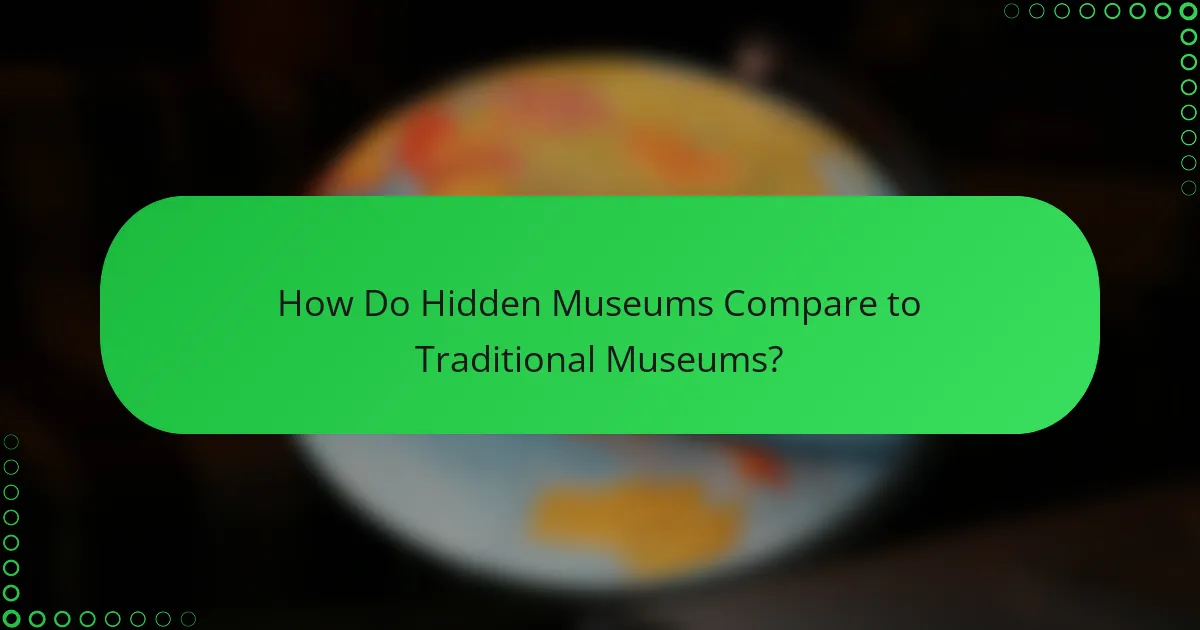
How Do Hidden Museums Compare to Traditional Museums?
Hidden museums often provide a more engaging experience than traditional museums by focusing on interactive exhibits designed for children and families. While traditional museums may emphasize static displays and historical artifacts, hidden museums prioritize hands-on learning and participation, making them ideal for fostering curiosity and creativity.
Focus on Interactivity
Interactivity is a hallmark of hidden museums, allowing visitors to engage directly with exhibits. This can include touchable artifacts, immersive environments, and participatory activities that encourage exploration. For example, a hidden museum might feature a science lab where kids can conduct experiments or an art studio where they can create their own masterpieces.
These interactive elements not only make learning fun but also cater to various learning styles. Children who may struggle with traditional learning methods often thrive in environments where they can touch, manipulate, and experiment. This hands-on approach can significantly enhance retention and understanding of complex concepts.
When visiting a hidden museum, look for programs that offer guided activities or workshops. These can provide structured learning experiences that further enrich the visit. Always check the museum’s schedule in advance to ensure you don’t miss out on special interactive events.
